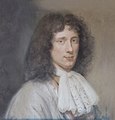Hofwijck

Hofwijck ( ˈɦɔfʋɛik ) (Latin name: Vitaulium ) is a mansion built in the 17th century , the Golden Age of the Netherlands , for the diplomat Constantijn Huygens . It is located on the Vliet in Voorburg , five kilometers from The Hague in the direction of Leiden . It has been a museum since 1928 .
The official address is Westeinde 2, Voorburg, Netherlands , better known today as Voorburg Station . The Knooppunt Prins Clausplein motorway junction is less than a kilometer away.
Edification
After becoming a widower, Huygens bought land on the Vliet in Voorburg to build a summer house. Back then it was considered contemporary to have a summer home on a river or canal; old maps of Voorburg show Hofwijck as one of many. The building itself and the gardens, which originally lay on both sides of the Vliet, were designed by Huygens himself in collaboration with his architect Jacob van Campen . The property should be part of a harmonious paradise on earth with a garden made for God. Huygens was very inspired by the classical works of the Roman architect Vitruvius of the first century BC . The architect Pieter Post was responsible for the actual construction work.
The building was erected in the classical style from bricks without plastering. It stands in the middle of a square around which the pond swan lies. Hofwijck was inaugurated in 1642 in the company of friends and relatives. Huygens had Hofwijck built so he could escape the tensions that life as a politician brought with it, and his name reflects this: "hof" means "(royal) court" and "wijck" means "escape". It has more than one meaning, however, because “courtyard” can also mean “garden” and “Wijck” can also mean “place”. The Latin name also has a double meaning: Vitaulium means "garden of life" and "garden of Vitruvius".
Most of the visitors came with barges . The delivery entrance is under the bridge.
Voorburg train station, Hofwijck gatehouse on the right .
After Huygens' death
When Constantijn Huygens died, Hofwijck was taken in by his son, the scientist Christiaan Huygens . The Huygens sold it in 1750. In the years that followed it was largely neglected and auctioned for demolition in 1849, which was prevented by the statesman Guillaume Groen van Prinsterer buying it. Around 1913 the “Vereniging Hofwijk” (Hofwijck-Verein) acquired the building when it threatened to be demolished again. Today it is a museum that first opened its doors on June 12, 1928. Between 1995 and 2005 the garden and building were restored and reopened on May 31, 2005 in the presence of Queen Beatrix .
From 1950 to 1970 Christiaan Huygens was depicted with Hofwijck on the Dutch 25 guilder note. In the 19th century , the city of Voorburg left the northern part of the garden to the Dutch Railway Authority for the construction of the railway, on condition that it received a railway connection. Intercity trains operated by the Nederlandse Spoorwegen stopped in Voorburg until 2006 . The Buitenplaats (Dutch country house ) Hofwijck was listed as monument number 508184 on November 4, 2002.
Replica in China
A replica of Hofwijck was built in Gaoqiao (Chinese 高桥), a planned town and suburb in the new development area of the Pudong community of Shanghai in the People's Republic of China ( 31 ° 20 ′ 27.9 ″ N , 121 ° 34 ′ 20.6 ″ E ). The Scheepvaartmuseum has been recreated right next to it. The replicas in and around the Holland Village ("Dutch Village") as Gaoqiao New Town ( New Town of Gaoqiao) were created as part of the One City, Nine Towns ( One City, Nine Towns ) initiative .
museum
The collection includes items belonging to the Dutch royal family that were involved in the work of Constantijn or his son Christiaan. Christiaan's room contains various types of clockwork and some original clocks. Throughout the building there are family paintings, furniture and Huygens' library, which is now a small office with many of his books. Every arriving boat could once be seen from her window; today you can see the Autobahn at eye level.
Christiaan Huygens' room with the pendulum in the church of Scheveningen
Prince Friedrich Heinrich of Orange , portrait by Gerard van Honthorst , 1650.
Portrait of Amalie zu Solms-Braunfels

Web links
- Official websites
- The poem about Hofwijck (Dutch), Leiden University (archive.org)
Individual evidence
- ↑ a b c d e f Ronald Stenvert, Chris Kolman, Saskia van Ginkel-Meester, Elisabeth Stades-Vischer, Sabine Broekhoven: Monuments in Nederland - Zuid-Holland . Waanders, Zwolle 2004, ISBN 90-400-9034-3 , pp. 516-517.
- ↑ a b c d e f g h i Jos Stöver, Vincent Collette, Rianne van Hilten, Robert van Lit, Carla Oldenburger-Ebbers, Heimerick Tromp: Kastelen en buitenplaatsen in Zuid-Holland . Walburg Pers, Zutphen 2000, ISBN 90-5730-078-8 , pp. 238-243.
- ↑ Monument number: 508184 Hofwijck Westeinde 2 2275 AD te Voorburg , Rijksdienst voor het Cultureel Erfgoed, December 22, 2017
Coordinates: 52 ° 3 ′ 54 ″ N , 4 ° 21 ′ 43 ″ E













